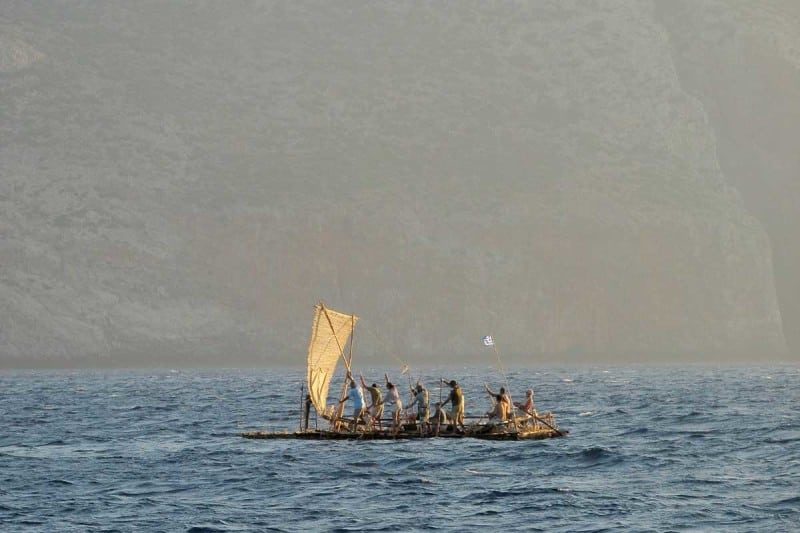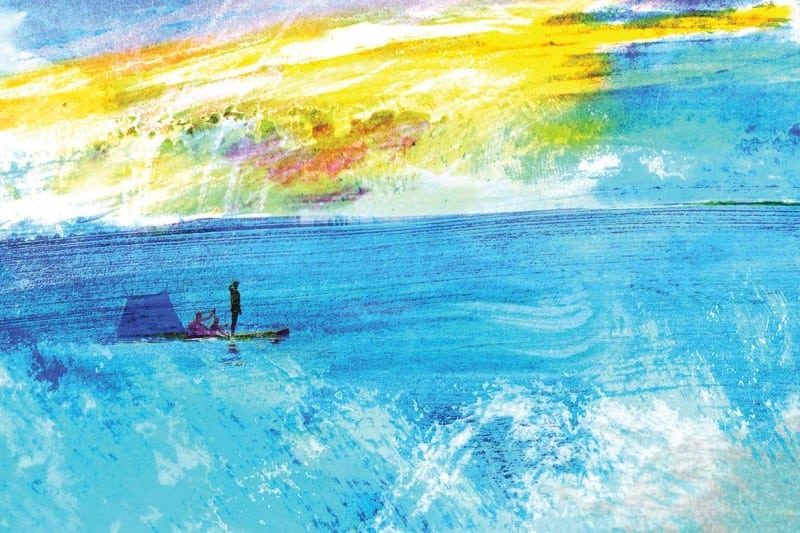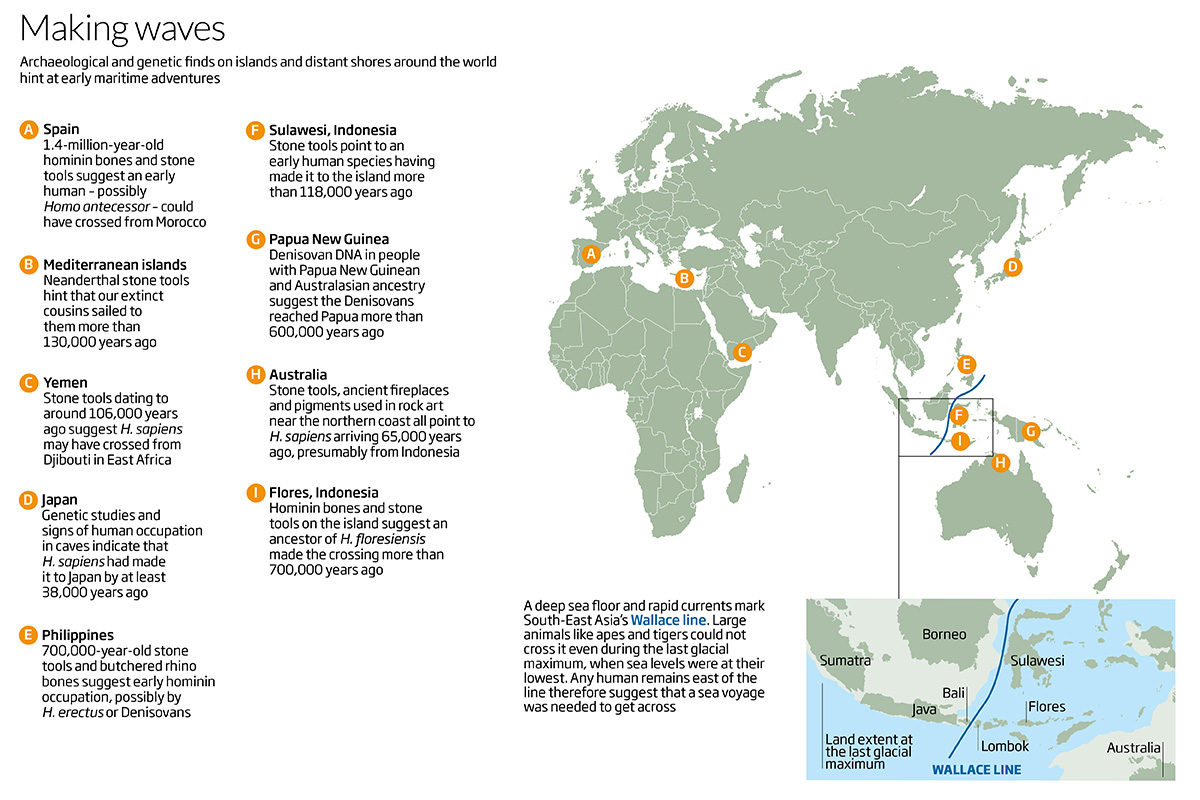IT WASN'T supposed to end this way. The 23-metre-long Nale Tasih 1, made with Stone Age tools and materials, was meant to recreate one of the truly epic prehistoric journeys: the first human crossing from Indonesia to Australia some 65,000 years ago. The voyage, in 1998, should have taken more than a week, but water sloshing around the crew's feet on the first day was a clear sign. The team had to tow the doomed raft back to shore.
The very first humans to travel the oceans would have faced a daunting task, both physical and mental. By attempting to recreate their voyages, experimental archaeologists are helping to define the scale of that challenge. The Nale Tasih 1 expedition, however, was meant to help prove a grander theory. Its leaders say humans have been building and using watercraft to reach new lands for the best part of a million years. In other words, early humans - potentially including Neanderthals, Denisovans and Homo erectus - weren't diehard landlubbers. They were mariners.
It is still a minority view, but one with profound implications. The ancient mariners theory could completely change our perspective on how early humans behaved and communicated with each other.
The broad consensus is that our species, Homo sapiens, largely took over the world on foot. Our ancestors walked out of Africa, through or around Arabia to South Asia, over to East Asia, and via various routes to Europe. They even walked to the Americas over a land bridge that once stretched from present-day Siberia to Alaska. The only major land mass that had to be reached by sea was Australia. We know that journey took place at least 65,000 years ago from stone tools, an ancient hearth and the leftovers of a meal, all discovered inside a rock shelter near the country's northern coast.
Comment: It would be worth bearing in mind when reading this article that, perhaps, in the distant past, Australia wasn't always separated by so vast a body of treacherous water. Because if sea levels were lower and the climate was milder, as a number of scientists propose, then the possibility of accessing these land masses may have much been easier.
Setting out for Australia was an astonishing leap of faith. The journey presumably began somewhere in Indonesia, and the voyagers may even have headed off into the open ocean with no sight of land. Nonetheless, "they absolutely knew there was a big continent down there", says Robert Bednarik, lead archaeologist on the Nale Tasih 1 enterprise. "The smoke from Australian bush fires rises up to 2 kilometres and that would certainly have been visible." Southerly bird migrations could also have offered clues. One recent study suggested that a string of islands may have offered stepping stones.
We may never know what kind of boat they used. To build the Nale Tasih 1 and its successor the Nale Tasih 2 - which did reach Australia after 13 gruelling days at sea - Bednarik and his collaborators made educated guesses based on what is readily available in Indonesia. They lashed many tonnes of bamboo together with vines, and wove sails out of palm-leaf fibres. Boats or rafts could also have been carved out of wood or woven from reeds, but either way the materials probably rotted away long ago.
Still, few archaeologists doubt that the first human voyage to Australia was deliberate and undertaken by sailors who are just a few thousand generations removed from us. Their ability to observe, reason and carry out an ambitious plan would have equalled our own. Things become far more controversial when it comes to the large and growing body of evidence that much earlier human species also put to sea (see map).
In the 1970s, archaeologists working on the Indonesian island of Flores began finding what appeared to be stone tools that predated H. sapiens alongside the remains of extinct animals. The discoveries were inconvenient, and largely ignored for decades.
An early human presence on Flores seemed particularly improbable because of the island's weird biology. During the 19th century, biologist Alfred Russel Wallace had noted that the islands to the north and west of Flores - including Borneo, Sumatra, Java and Bali - are typically inhabited by Eurasian species like orangutans and tigers. They are largely absent to the south and east, on Flores and other islands including Sulawesi, Lombok and Sumbawa. Eventually biologists came up with an explanation. In prehistory, sea levels were so much lower that Borneo, Sumatra, Java and Bali were part of the mainland, but a deep marine trench to the south-east, swirling with strong currents, kept Sulawesi, Flores and their neighbours separate. In other words, snaking through the islands of South-East Asia is an invisible species barrier, now dubbed the Wallace line, that apes and tigers could not have walked or swum across. In places it is narrow: the strait between Bali and Lombok is little more than 20 kilometres across, but remains impassable to large species.
In the 20th century, it was generally agreed that Eurasian megafauna - species the size of humans or larger - had breached the Wallace line perhaps just twice. First across were elephants, powerful swimmers whose relatives left fossil remains on Flores and elsewhere. Then came H. sapiens, who must have breached the Wallace line en route to Australia around 65,000 years ago.
To most researchers it seemed impossible that some form of human had made it across the Wallace line hundreds of thousands of years before our species evolved. Today, though, we can no longer ignore the evidence from Flores, since supplemented by human remains dating back 700,000 years. It's not clear exactly where these ancient humans fit in our evolutionary tree, but one thing is certain: they did cross the Wallace line.
Bednarik argues that they must have done so intentionally. Beginning with the Nale Tasih 1, he has spent 20 years building proxies for prehistoric rafts and attempting to repeat journeys to places like Australia and Flores. In doing so, he is upholding a grand tradition of experimental maritime archaeology that stretches back to the 1940s, when Norwegian adventurer Thor Heyerdahl rafted thousands of kilometres from South America to Polynesia.
Among Bednarik's voyages have been a fair number of failures, including an attempt to cross the Wallace line in 1999. The first raft his team launched from Bali had a crew of six rowers, but their efforts were no match for the currents. By January 2000 his team had built another raft, strong and buoyant enough to carry a dozen rowers. This time they reached Lombok, but only after 12 hours of furious paddling and some good fortune with the currents. "We made it by a whisker," says Bednarik.
In his judgement, the experiment disproves what has become the accepted explanation for Flores's ancient human inhabitants: that they were unintentional mariners, plucked from the shore by a storm and swept across the Wallace line. "It's just not possible to cross a [strait] passively without anything pushing you," he says. Curtis Runnels at Boston University says Bednarik's experiments may not prove that early humans built and used seacraft, but they show it is at least theoretically possible. "The stone tools and reed bundling were well within the capacities and capabilities of what we know about early humans," he says.
Accidental mariners?
Most other archaeologists are not so sure, particularly because we have no way of knowing whether ancient humans really crossed at the Lombok Strait. It is possible they breached the Wallace line much further north, where the currents are - and probably were - less strong.
We know, for instance, that small monkeys somehow made it across the line to Sulawesi, and clearly they didn't use boats - in all likelihood they floated over on mats of vegetation. Gerrit van den Bergh at the University of Wollongong in Australia has found stone tools on Sulawesi that are at least 100,000 years old, and thinks this is where the first Floresians came from. Just last month a team announced they had found 700,000-year-old stone tools in the Philippines, offering another possible route.
But there are fundamental problems with the idea that ancient humans reached islands entirely by accident. For starters, "tsunamis kill people", says Runnels. "They don't float them out to sea on huge rafts of vegetation with sufficient food to [survive a] long drift."
Then there is what has been dubbed the Robinson Crusoe problem. A single individual surviving on an accidental raft couldn't possibly establish a viable population on a new shore. "To be archaeologically visible, you need thousands of people," says Bednarik. Even if small animals like monkeys crossed the Wallace line accidentally, it does not follow that humans did so too. And although an accidental raft could carry dozens of small monkeys, it is hard to imagine one able to transport hundreds of people. This would explain the absence - elephants aside - of large Eurasian animals on the far side of the Wallace line, and lends support to the idea that ancient humans crossed it deliberately.
Even so, most archaeologists are adamant that the ancient mariner theory is wrong. There may be a simple reason for their intransigence. Bednarik reasoned that ancient humans would have built rafts out of bamboo, which is plentiful in South-East Asia, but his experiments revealed this was no simple task. Freshly felled bamboo is relatively easy to cut and carve with stone tools, but that becomes very difficult once it dries. On the other hand, only several months of careful drying will give bamboo the necessary buoyancy.
The conclusion? Early humans wouldn't have cobbled rafts together on impulse. Building a seaworthy vessel took months of planning, suggesting it was impossible without advanced communication skills. Indeed, earlier this year, the linguist Daniel Everett at Bentley University in Massachusetts used the controversial evidence for ancient seafaring to argue that species like H. erectus must have had abstract language. What's more, Bednarik's voyages show that failure, and potentially death, would have been close companions of the ancient mariners' attempts. He thinks they would have needed persuasive arguments to convince others to commit to such journeys.

On one level, the debate on ancient mariners and their language skills seems to be locked in stalemate. "Arguments about language have been going on in anthropology and archaeology for more than a century," says Runnels. "I do not believe that any hominin lacked language ability. Hell, the birds and the elephants and the dolphins talk to each other and so do we." But it is just possible that new discoveries could lead to a resolution.
Leppard is particularly interested in the fact that the human bones found on Flores - including "Flo", the famous hobbit skeleton that stands little more than a metre tall - all seem to belong to unusually small individuals. Animals tend to evolve into new species with unusual body sizes when they arrive on islands, but only if the populations are genetically isolated from mainland ones. "If whichever hominin got to Flores was sailing back and forth on a whim, I do not see how gene flow could have been restricted such that speciation could occur," he says.
Comment: There are other possibilities that may have brought about this selection process.
"Building a seaworthy raft required months of planning - and language"
As ancient DNA studies continue to throw new light on the prehistoric world, they could reveal whether populations on opposite sides of narrow seas were in genetic contact. For instance, earlier this year a study suggested there was limited contact 15,000 years ago between humans in Morocco and the populations a few tens of kilometres to the north across the Strait of Gibraltar.
Comment: Which is just before the suggested time of the Younger Dryas Impact: Of Flash Frozen Mammoths and Cosmic Catastrophes
If, on the other hand, ancient humans really have been building rafts for the best part of a million years, we can expect archaeologists to dig up signs of human activity in places and at times that just don't fit with expectations.
One such discovery was announced last year. At a site in California, researchers found the 130,000-year-old carcass of a mastodon alongside what they claimed were simple stone tools. If someone butchered the animal, they did so comfortably 100,000 years before most researchers think humans reached the New World. Many archaeologists quickly dismissed the Californian evidence. Both van den Bergh and Runnels remain open-minded. It is worth remembering that the simple stone tools found on Flores back in the 1970s were also dismissed and ignored for decades, but aren't any longer.
"Clearly we need to be guided by the evidence," says Runnels. "But if we don't ask questions - for instance, did early hominins reach California by 130,000 years ago? - and test the hypotheses that result from them, we cannot get answers."
This article appeared in print under the headline "Stone Age sailors"





Comment: When we consider that the 'Out of Africa' theory is still only a theory and that the planet may have been very different to how it is today, it's clear that this issue of whether human's were capable sea-farers becomes a lot more interesting: